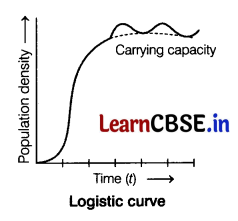Students must start practicing the questions from CBSE Sample Papers for Class 12 Biology with Solutions Set 3 are designed as per the revised syllabus.
CBSE Sample Papers for Class 12 Biology Set 3 with Solutions
Time : 3 Hours
Maximum Marks : 70
General Instructions:
- All questions are compulsory.
- The question paper has five sections and 33 questions. All questions are compulsory.
- Section-A has 16 questions of 1 mark each; Section-B has 5 questions of 2 marks each; Section-C has 7 questions of 3 marks each; Section-D has 2 case-based questions of 4 marks each; and Section-E has 3 questions of 5 marks each.
-
There is no overall choice. However, internal choices have been provided in some questions.
A student has to attempt only one of the alternatives in such questions. - Wherever necessary, neat and properly labelled diagrams should be drawn.
Section A
Question 1.
Identify the role of polar bodies during oogenesis.
(a) Polar bodies ensure that the ovum contains the most of cytoplasm
(b) They rid the body of defective sets of chromosomes, leaving the good set within the ovum
(c) They are merely the byproduct of meiosis and serve no function
(d) They prevent the development of most sets of multiple births
Answer:
(a) The polar bodies are formed during oogenesis in females to conserve cytoplasm for ovum which ensures that the ovum contains the most of cytoplasm.
Question 2.
The features of genetic code that allow bacteria to produce human insulin by recombinant DNA technology is
(a) genetic code is redundant
(b) genetic code is nearly universal
(c) genetic code is specific
(d) genetic code is not ambiguous
Answer:
(b) Bacteria is able to produce human insulin because genetic code is nearly universal in all organisms. For example, the codon AGG specifies amino acid arginine in bacteria, animals and plants.
Question 3.
Given below are the phenomenon which deviates from Mendel’s law of inheritance and their descriptions.
| Phenomenon | Descriptions |
| A. Incomplete dominance | 1. In heterozygous organisms both alleles expresses themselves completely. |
| B. Polygenic inheritance | 2. Multiple genes govern a single character. |
| C. Codominance | 3. Frhybrid does not resemble either of its parents. |
| D. Pleiotropy | 4. A single gene influences many traits. |
Select how many phenomenon are correctly matched with their descriptions?
(a) 1
(b) 3
(c) 2
(d) 4
Answer:
(c) Polygenic inheritance and pleiotropy are correctly matched while, rest can be corrected as
In incomplete dominance, the Frhybrid does not resemble either of its parents.
In heterozygous organism both alleles expresses themselves completely in codominance.
![]()
Question 4.
Evolutionary divergence is marked by the development of
(a) common set of structures in closely related groups
(b) dissimilar set of functions in unrelated groups
(c) common set of structures in unrelated groups
(d) dissimilar set of functions in closely related groups
Answer:
(d) Evolutionary divergence is marked by the development of different functional structure originating in organisms arising from a common ancestral form.
Question 5.
A biocontrol agent to be a part of an integrated pest management should be
(a) species-specific and symbiotic
(b) free-living and broad spectrum
(c) narrow spectrum and symbiotic
(d) species-specific and inactive on non-target organisms
Answer:
(d) A biocontrol agent relies on natural predation and not on chemicals. According to IPM, these should be species-specific in nature and should be inactive on the non-target organisms in contrast of chemical . pesticides that kills both useful and harmful life forms indiscriminatively.
Question 6.
Where will you look for the sporozoites of the malarial parasite?
(a) RBCs of humans suffering from malaria
(b) Spleen of infected person
(c) Salivary glands of freshly moulted female Anophek.s mosquito
(d) Saliva of infected female Anopheles mosquito
Answer:
(d) When an infected female Anopheles bites a healthy peson. Pasmodium in the form of
sporozoites are transmitted from saliva of mosquito into the human body. Thus, one can look for the
sporozoltes of the malarial parasite in the saliva of the infected female Ancpheles mosquito.
Question 7.
The tropical Amazonian rainforest in South America has the greatest biodiversity on the earth. This is because of
(a) stable climate in tropics
(b) huge distance from the equator
(c) warm temperatures with low humidity
(d) higher altitudes
Answer:
(a) Tropics regions lie near to the equator. As a result, they receive more solar energy, have warm temperatures with high humidity. This makes the climate stable, which allows many species to flourish over the period of time. This is why tropics are greatest biodiversity regions.
Question 8.
The graph given below shows the rate of growth in a population.
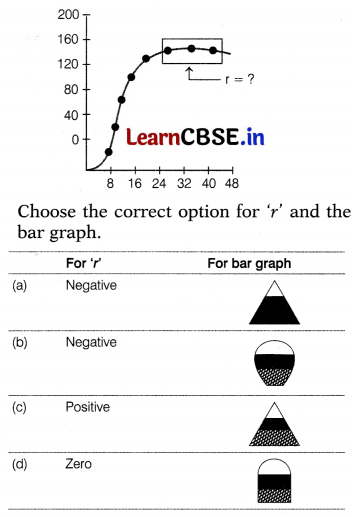
Answer:
(d) A stable population is the one with a zero growth rate, i.e. r = b – d, if birth rate and death rates remain constant, r = 0.
Thus, the population is neither growing nor dimnishing and this is indicated in the bell-shaped age pryamid. Hence, the option (d) is correct.
Question 9.
Genetic engineering techniques include
(a) altering genetic material
(b) sequencing genetic material
(c) studying genetic material
(d) None of the above
Answer:
(a) Genetic engineering includes techniques which alter the chemistry of genetic material (DNA and RNA) to induce the expression of genes which will give the desired products.
![]()
Question 10.
A digestive enzyme P synthesised by organism Q is used in clarifying procedure of bottled beverages, in tannaries and detergent making, etc. Which of the following options identify P and Q, respectively?
| P | Q | |
| (b) | Lipase | Lipolytica |
| (c) | Amylase | Aspergillus oryzae |
| (d) | Rennet | Mucor |
| (a) | Protease | Bacillus subtilis |
Answer:
(d) Protease (P) is a digestive enzyme, synthesised by many bacteria such as Bacillus subtilis (Q), Bacillus licheniformis fungi like Aspergillus oryzae, etc. It has many uses like in extraction of fish oils, in meat industry, cheese and bread industry, tannaries and in clarification of bottled beverages.
Question 11.
Silencing of a gene can be achieved by the use of
(a) an antisense construct of specific mRNA
(b) degrading the mRNA
(c) foreign genes
(d) deleting certain chromosome parts
Answer:
(a) Silencing of a gene can be achieved by using an antisense construct of mRNA. This method involve silencing of specific mRNA due to complementary cfeRNA molecule that binds to and prevents translation of the mRNA.
Question 12.
Study the following flowchart of biogas production and select the correct option for A, B and C.
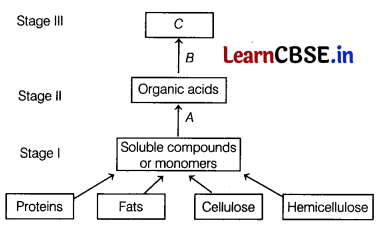
(a) A-Methanogenic bacteria, B-Fermentative microbes, C-CO
2
and hydrogen (biogas)
(b) A-Anaerobic microorganisms, B-Methanococcus, C-CO
2
and nitrogen (biogas)
(c) A-Anaerobic microbes, B-Methanogenic bacteria, C-CO
2
and methane (biogas)
(d) A-Aerobic microorganism, B-Methanobacterium, C-CO
2
and methane (biogas)
Answer:
(c) The correct option for A, B and C is (c) as
anaerobic microbes, methanogenic bacteria, CO
2
and methane (biogas), respectively.
In stage-I, anaerobic microorganisms (A) bring about enzymatic breakdown of complex organic compounds into simple soluble compounds or monomers.
In stage-II, monomers are converted into organic acids by fermentating microbes.
In stage-III, organic acids are acted upon by methanogenic bacteria (B) to produce methane rich mixture of gases called biogas (C),
Question Nos. 13 to 16 consist of two statements, Assertion (A) and Reason (R). Answer these questions selecting the appropriate option given below.
(a) Both Assertion and Reason are true and Reason is the correct explanation of Assertion
(b) Both Assertion and Reason are true, but Reason is not the correct explanation of Assertion
(c) Assertion is true, but Reason is false
(d) Assertion is false, but Reason is true
Question 13.
Assertion (A) : Embryos of fish, salamander, tortoise, chick and a man of same age resemble each other closely.
Reason (R) : This verifies that ontogeny recapitulates phylogeny.
Answer:
(a) Both Assertion and Reason are true and Reason is the correct explanation of Assertion.
The early embryos in a vertebrates share remarkable similarities to the extent that human embryo is difficult to differentiate from embryos of chick, lizard, frog or fish in early stages. This is explained by biogenetic law proposed by Haeckel. It describes that ontogeny recapitulates phylogeny, i.e. the development of embryo is the recapitulation of ancestral sequence.
Question 14.
Assertion (A) : Sex education in schools is necessary.
Reason (R) : This will provide correct information and prevent any myths or misconceptions with respect to reproductive health.
Answer:
(a) Both Assertion and Reason are true and Reason is the correct explanation of Assertion.
Introduction of sex education in schools should be encouraged. This helps in conveying correct information to young children about sex related aspects. Instead of behaving false facts or myths which can develop knowledge of right and wrong practices.
Question 15.
Assertion (A) : The pyramid of number of pond ecosystem is upright.
Reason (R) : Phytoplanktons are maximum and secondary consumers are lesser in number.
Answer:
(a) Both Assertion and Reason are true and Reason is the correct explanation of Assertion.
The pyramid of number of pond ecosystem is upright, because base of this pyramid is occupied by the maximum number of phytoplanktons (autotrophs) and number of individuals gradually decreases towards the primary and secondary consumers side, respectively.
![]()
Question 16.
Assertion (A) : DNA has two chains having antiparallel polarity.
Reason (R) : In one chain of DNA at one end has a free phosphate moiety 5′ end of ribose sugar and at other end the ribose has a free 3′ OH group.
Answer:
(a) Both Assertion and Reason are true and Reason is the correct explanation of Assertion.
The two chains of DNA have antiparallel polarity. This is because one chain has a free phosphate moiety at the 5′ end of the ribose sugar and another chain has a free 3’OH moiety at the 3’end.
Section B
Question 17.
A true-breeding tall pea plant is crossed with a true-breeding dwarf variety of pea plant. With the help of Punnett square show the above cross and mention the results obtained with respect to genotype and phenotype in F
1
-generation.
Answer:
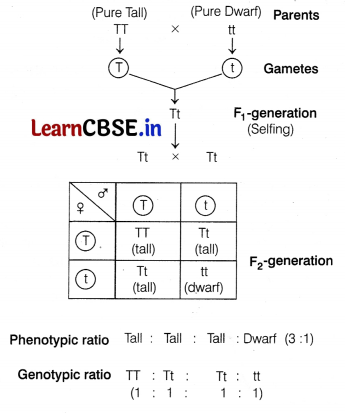
Question 18.
In the figure below, parts A, B and C are veiy essential for this structure and influences the process of fertilisation. Study the figure and answer the questions that follows.
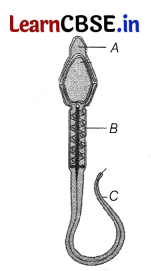
(i) Name this structure, along with parts labelled A-C.
(ii) How does part A help in the process of achieving successful fertilisation?
Answer:
(i) The structure is of human sperm (male gamete). Parts labelled A-C are,
A – Acrosome
B – Mitochondria
C – Tail
(ii) Part A, i.e. the acrosome lies at the tip of the nuclei. It contains hydrolytic enzymes which helps in penetrating the layers of ovum and perform fertilisation by fusion of haploid nucleus of sperm and ovum.
Question 19.
The graph given below shows the percentage of the use of ART methods, i.e. ZIFT and GIFT in 15 years. Interpret the graph and explain how these methods are releated to the aspects of reproductive health.
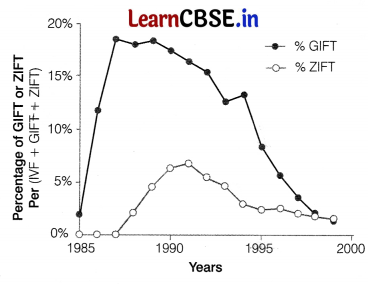
Answer:
According to the graph the GIFT gained popularity quickly, but has become less common in several years. On the other hand ZIFT is used by couples in later years, but it has never been as popular as GIFT.
Both ZIFT and GIFT are the methods of assisted reproductive technology, which are used to correct the problems related to infertility in both the sexes.
In the process of ZIFT zygote upto 8-blastomeres stage are placed in the oviducts and allow to grow normally while in the process of GIFT ovum are collected from a donor and transterred into the Fallopian tube of another female who cannot produce one.
Forgetting maximum marks, following value point should be Points added in answer.
Briefly describe the process of ZIFT and GIFT.
![]()
Question 20.
Refer to the given figure representing different zones of a biosphere reserve.
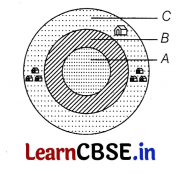
(i) The figure represents which strategy of species conservation?
(ii) Name and explain about areas labelled A-C. Also explain why no human activity is allowed in area A.
Answer:
(i) The figure represents the biosphere reserve which is an in situ strategy (i.e. within the natural habitat of organism) of conservation.
(ii) Area A-C are identified as core zone (A), buffer zone (6) and transition zone (C), respectively.
The core zone is a specially protected area, dedicated to species conserved there. To avoid any type of hunting, killing, trading activities, humans are not allowed in this area a part from those who are involved in management activities.
Question 21.
If the sequence of nitrogen bases in the coding strand of DNA in a transcription unit is
5′ – A T G A A T G – 3′
What would be the sequences of bases in its RNA transcript? Explain the changes that occur in the transcript.
Or
Use the information provided in the table given below to answer the following questions.
| Lactose | Glucose | Lac repressor | Lac operon expression level |
| Present | X | Inactive | Very high |
| Y | Present | Inactive | Medium |
| Absent | Absent | Active | Very low |
| Absent | Absent | Active | Very low |
(i) Fill the gap is X and Y.
(ii) Give reason why does the lac operon shut down for same time after addition of lactose in the medium.
Answer:
The sequence for the template strand can be 3′-TACTTAC -5′. Flence, the sequence of bases in the RNA transcript strand, following Chargraff’s rule will be
5′ – AUGAAUG – 3′
As the mRNA sequence would be complementary to the template. Excepting the base thymine (T), which gets replaced by uracil (U) at all positions.
Or
(i) X – Absent (Glucose), Y – Present (Lactose)
(ii) Lac operon shut down for some time after the addition of lactose in the medium because, after the addition of lactose beta galactosidase performs the complete breakdown of lactose into glucose and galactose.
Section C
Question 22.
Refer to the figure given below and answer the following questions.
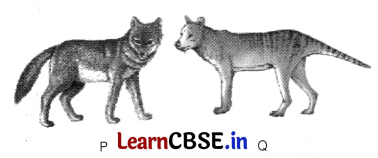
(i) Name the process by which Q came into existence. Where else you seen the same type of evolution?
(ii) Describe this process and how it ; operates in the nature?
Answer:
(i) This process is adaptive radiation. It has also been observed in the evolution of finches living in the Galapagos Island.
(ii) Adaptive radiation comes into play when a single or a small group of ancestral species rapidly diversifies into a large number of descendants with different adaptive forms.
These forms exhibit modification in organ structures which are basically similar to ancestral species, but adapted to exploit the resources in their habitats or support their lifestyles. Adaptive radiation thus, leads to divergence where the development of different functional forms occurs from a common ancestral form.
Question 23.
Explain the functions of the 3 layers, i.e. endothecium, middle layers and tapetum in the microsporangium of a plant.
Answer:
- Endothecium : It serves as a protective layer and aids in the dehiscence of anther to allow the discharge of pollen from the plant.
- Middle layers : It is protective in function and also store reserve food during early stages of microspore development.
- Tapetum : It provides nutrition to the pollen grains and produces pollenkit materials.
Question 24.
You are given tall pea plant with yellow seeds, whose genotypes are unknown.
(i) How would you find the genotype of this plant?
(ii) Explain point (i) with the help of a cross.
Answer:
(i) Test cross will be performed to know the genotype of this plant,
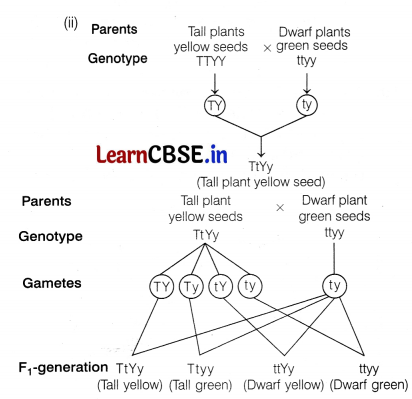
The phenotypic and genotypic ratios are 1 : 1 : 1 : 1.
The given plant is heterozygous for both the traits, i.e. TtYy.
![]()
Question 25.
Given below is an autoradiograph of DNA segments, obtained from gel electrophoresis.
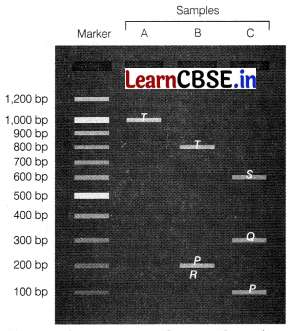
(i) In this autoradiograph, the ladder sequence measures approx. 1200 base pairs, which band will correspond to 600 bp?
(ii) On what basis the fragments get separated like this during gel electrophoresis? Mention one significance of this technique while conducting a recombinant molecule.
Answer:
(i) The bands (P – 7) corresponding to, 600 bp length is band S.
(ii) In gel electrophoresis, the cut pieces of DNA separates on the basis of size, shape and molecular weight. An electric current is passed through the gel. Since, DNA carries negative charge, thus it gets attracted towards the positive charge and moves toward anode. The smaller fragments move faster as they experience lesser friction than the longer ones.
In RDT, electrophoresis is used to purify and separate the DNA fragments cut by specific restriction enzyme. These sequences are used in creation of recombinant DNA.
Question 26.
‘In some children, ADA deficiency can be cured by bone marrow transplantation or by enzyme replacement therapy, but both of these approaches are not completely curative’. Justify the statement.
Answer:
Adenosine Deaminase (ADA) deficiency is an inherited disorder that damages the immune system.
ADA deficiency leads to accumulation of toxic purine degradation byproducts, which affect lymphocytes and lead to adenosine deaminase-deficient severe combined immuno deficiency. It is traditionally cured using two approaches viz., enzyme replacement therapy and bone marrow transplant.
In enzyme replacement therapy, an intramuscular injection containing the missing enzyme is injected weekly or monthly.
In bone marrow transplant, bone marrow laden with missing enzyme is transplanted from sibling donor. Both of these approaches are not completely curative.
In former, painful weekly injections are to be taken regularly and it may not be effective over time.
The latter procedure require suitable donor which is not easily available all the time. Over these two procedures, gene therapy can provide significant long term benefits to patients and can provide complete cure.
Question 27.
A GM or transgenic crop is a plant that has a novel combination of genetic material obtained through the use of modem biotechnology. For example, a GM crop can contain a gene that has been artificially inserted instead of the plant acquiring it through pollination. The resulting plant is said to be genetically modified although in reality all crops have been ‘genetically modified’ from their original wild state by domestication, selection and controlled breeding over long periods of times.
(i) What effect do eating genetically modified foods have on your genes?
(ii) Why should foods derived from genetically modified crops be tested for possible reactions in people?
(iii) Are foods derived from genetically modified crops nutritionally superior?
Or
At the murder spot of Rishabh, police investigating team found a small spot of blood. They called the forensic team to collect the blood sample. Forensic team performed the PCR and police with the help of the PCR report cracked this case.
(i) What is PCR and a primer?
(ii) What is the denaturation process?
(iii) Name the bacteria from where thermostable DNA polymerase isolated.
Answer:
(i) There are no effects found related to Genetically Modified (GM) foods currently in the market.
(ii) Genetically modified crops should be tested for possible reactions in people, because these crops are prepared by the insertion of gene of the other species into their DNA. So, there is a possibility that they can cause some health issues, i.e. allergies due to release of new kind of proteins. Hence, GM crops should be tested.
(iii) Most of the genetically modified crops currently available are designed to reduce farmers’ production costs. They are neither better nor worse than foods from conventional crops.
Or
(i) PCR stands for Polymerase Chain Reaction. In this process, multiple copies of the gene of interest is synthesised in vitro.
Primers are the chemically synthesised oligonucleotides that are complementary to the regions of DNA.
(ii) Denaturation is the first step of PCR in which DNA strands get denatured by using high temperature of 95°C for 15 second.
(iii) Thermostable DNA polymerase is isolated from the bacterium Thermus aquaticus.
Question 28.
List the different parts of human oviduct through which the ovum travels till it meets the sperm for fertilisation. Also comment on the location and function of seminal vesicle.
Answer:
The different parts of human oviduct through which the ovum travels, till it gets fertilised are given below in the sequence
- Fimbriae : The finger-like projections that collect or catch the ovum after ovulation.
- Infundibulum : Ovum from fimbriae is guided into funnel-shaped infundibulum, that is part of Fallopian tube.
- Ampulla : A wider part of oviduct that leads ovum into isthmus.
- Isthmus : With narrow lumen and in the portion or junction of ampulla-isthmus, the ovum gets fertilised.
Seminal vesicle are accessory glands of male reproductive system. These are located between the bladder and rectum.
Seminal vesicle produces an alkaline secretion that neutralises the acidic environment of the male urethra as well as that of female reproductive tract.
![]()
Section D
Q. Nos: 29 and 30 are case-based questions. Each question has 3 subparts with internal choice in one subpart.
Question 29.
Bar graph shows reason for not using of modern contraception methods among current married women.
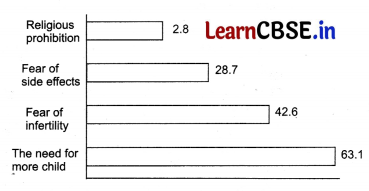
(i) On the basis of above histogram, what will be the impact of this scenario on the population of a country?
(ii) What can be the ideal contraceptive method for them? Support your answer by giving a suitable reason.
(iii) Why is birth control so important?
Or
(iii) What are the programmes/schemes launched by the government to promote family planning in the country?
Answer:
(i) It will cause the population to grow, leading to population explosion.
(ii) The ideal contraceptive method is male condoms that are up to 98% effective in preventing pregnancy and does not have any side effects.
(iii) Birth control is also known as contraception. As it reduces pregnancy-related morbidity and mortality, reduces the risk of developing certain reproductive cancers.
Or
(iii) The following programmes/schemes have been launched by government to promote family planning in the country.
(a) Scheme for home delivery of contraceptives by ASHAS.
(b) Increasing male participation and promotion of non-scalped vasectomy.
Question 30.
An experiment was conducted to measure the time taken by a person in response after seeing light. This person was given an alcoholic drink after every half hour and test was repeated.
The given below graph shows the result over two hours.
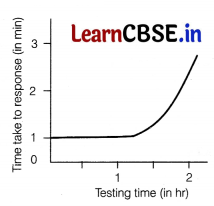
(i) With reference to the above graph, what difference was observe after one hour?
(ii) What can be the reason for the observations that you made in (i)?
(iii) Write down the effect of alcohol consumption.
Or
(iii) If regular dose of alcohol is discontinued. What would be the affect of it on individual?
Answer:
(i) It is observed that after one hour, the person’s capability of seeing light decreases due to the effect of alcohol.
(ii) Alcoholic drinks made the person react more slowly as it affect the central nervous system.
(iii) Effect of alcohol consumption include euphoria, peptic ulcer, gastric carcinoma, hepatitis, liver failure, liver cell carcinoma, etc.
Or
(iii) If regular dose of alcohol is discontinued, it will anxiety, shakiness, nausea, sweating and sometime it can be so severe that it may be life threatening.
Section E
Question 31.
Placed below are case studies of some people who were not feeling normal. They showed some symptoms which are tabulated below. Identify the diseases and suggest some preventive measures against the diseases.
| Disease symptoms | Diseases | Preventive measures | |
| Person 1 | High fever (39-40°C) weakness, stomach pain, loss of appetite | ||
| Person 2 | Fever, chills, cough headache, greyish to bluish colour of lips and finger tips. | ||
| Person 3 | Dry, scaly lesions on skin, nails and scalp with intense itching. | ||
| Person 4 | High fever, severe headache, pain in joints, nausea and vomiting. | ||
| Person 5 | Nasal congestion and discharge, sore throat, cough, hoarsness. |
Or
A chemist synthesises five new chemical compounds in the laboratory and name them as P
1
, P
2
, P
3
, P
4
and P
5
. After analysing them, he used these compounds in different fields. Explain briefly about the products (P
1
– P
5
) and their sources.
| S. No. | Chemical compounds | Application |
| 1. | P 1 | As immunosuppressive agent |
| 2. | P 2 | Blood cholesterol lowering agent |
| 3. | P 3 | Used as clot buster |
| 4. | P 4 | Removal of oil stains |
| 5. | P 5 | Conversion of milk to curd |
Answer:
| Disease symptoms | Diseases | Preventive measures | |
| Person 1 | High fever (39-40°C) weakness, stomach pain, loss of appetite. | Typhoid |
•Drinking safe and hygienic water.
• Washing hand before eating. |
| Person 2 | Fever, chills, cough, headache, greyish to bluish colour of lips and finger tips. | Pneumonia | • Drink warm beverages, take steamy baths and avoid smoking |
| Person 3 | Dry, scaly lesions on skin, nails and scalp with intense itching. | Ringworms |
• Keep skin dean and dry.
• Avoid sharing the belongings of the infected person like towel, clothes. |
| Person 4 | High fever, severe headache, pain in pints, nausea and vomiting. | Dengue |
• Keep doors and windows closed as much as possible.
• Bearing long sleeves and pants. • Avoid stagnant water |
| Person 5 | Nasal congestion and discharge, sore throat, cough, hoarsness. | Common cold |
• Wash hands frequently.
• Avoid touching your face and nose. • Disinfect contaminated objects and surface. |
Or
P
1
-cyclosporin-A It is obtained from fungus Trichoderma polysporum.
It is used as an immunosuppressive agent in organ transplant patients.
P 2 -statin It is produced by the yeast Monascus purpureus which have been commercialised as blood cholesterol lowering agent.
P 3 -streptokinase It is produced by the bacterium Streptococcus and modified by genetic engineering to be used as a ‘clot buster’ for removing clots from the blood vessels of patients.
P 4 -lipases It is obtained most commonly from Bacillus spp. Pseudomonas spp. and from several other microorganisms. It is used in detergent formulation and are helpful in removing oily stains from laundry.
P 5 -lactic acid It is obtained from Lactobacillus which are used to convert milk into curd.
![]()
Question 32.
In 1950s, there were hardly any mosquitoes in Delhi. The use of the jpesticide, DDT on standing water killed their larvae. But, now there are large number of mosquitoes that are resistant to DDT.
(i) State the reason, how that could have happened?
(ii) How natural selection favoured the DDT-resistant mosquitoes?
(iii) Expand DDT and which type of natural selection can be observed in DDT resistance in insects?
Or
Given below is a pedigree chart showing the inheritance of a certain sex-linked traits in humans.
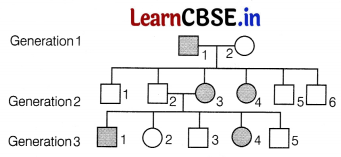
(i) On the basis of the inheritance pattern exhibited in this pedigree chart, what conclusion can you draw about the pattern of inheritance?
(ii) If the individual 1 from generation 3 married a normal female, what would be the probability of their daughter being a carrier?
(iii) Draw a Punnett square and give the genotypic percentage and phenotype of the offsprings when individual 4 from generation 3 is crossed with an affected male.
Answer:
(i) (a) There were some iarvae with a mutated gene that conferred resistance to DDT.
(b) The DDT resistant larvae survived while others died. The DDT – resistant larvae reached adulthood and reproduced in large numbers.
(ii) DDT becomes ineffective so quickly, because DDT resistant mosquitoes exist at low frequency in the global mosquito population and when a local population is sprayed, a strong force of selection in favour of the resistant mosquitoes is immediately created.
(iii) Dichloro diphenyl trichloroethane. Directional selection can be observed in DDT-resistance in insects.
Or
(i) The pattern of inheritance is X-linked dominant. It is a mode of genetic inheritance by which a dominant gene is carried on the X-chromosome.
(ii) If the individual 1 from generation 3 married a normal female, then the probability of their daughter being a carrier is 50%.
The schematic representation of the pedigree is as follows
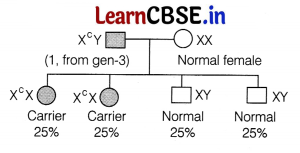
(iii) If individual 4 from generation 3 is crossed with an affected male the cross obtained will be as given below
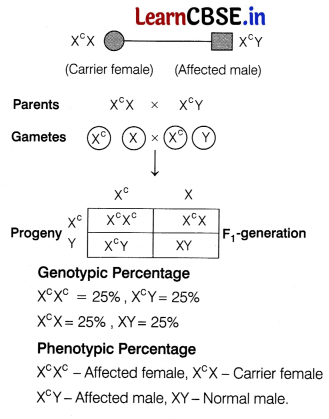
Question 33.
What is pyramid of biomass?
Explain in detail with the help of a pyramid showing decrease level of biomass towards tertiary consumer.
Or
Draw and explain a logistic curve for a population of density (N) at time t whose intrinsic rate of natural increase is r and carrying capacity (K).
Answer:
Biomass is the total dry mass or organic matter in organisms or ecosystem. A pyramid of biomass shows the mass of organic material at each trophic level. The biomass of the successive trophic levels decreases progressively due to the loss of energy at each successive level. Respiration and excretion are the two main processes in which both energy and bidmass are lost at each stage of a food chain. The total biomass of food from the producer is the largest and total biomass of food available to higher trophic levels becomes smaller and smaller. Higher trophic levels, therefore usually contain very small numbers of large organisms with a low total biomass per unit area of the ecosystem.
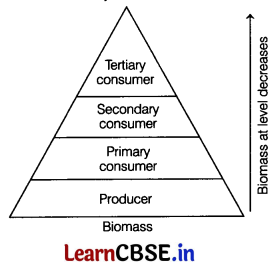
Or
- Population initially shows a lag phase and then shows a phase of acceleration or exponential growth followed by the phase of deceleration.
- Population can grow exponentially for a certain period of time and then assumes a steady state, as the resource availability becomes limited at some point of time.
- Every environment has resources to support a particular maximum number of individuals, called its carrying capacity (K). Beyond that, there is no increase in the size/density of a population.
- A population showing logistic growth shows a sigmoid curve, when the number of individuals is plotted as a function of time.
-
Equation can be described as
[later]\frac{d N}{d t}[/latex] = rN(\(\frac{K-N}{K}\))
Where, N = Population density at timef
r = Intrinsic rate of natural increase
K = Carrying capacity. - The model is more realistic in nature, because no population can sustain the exponential growth indefinitely.
